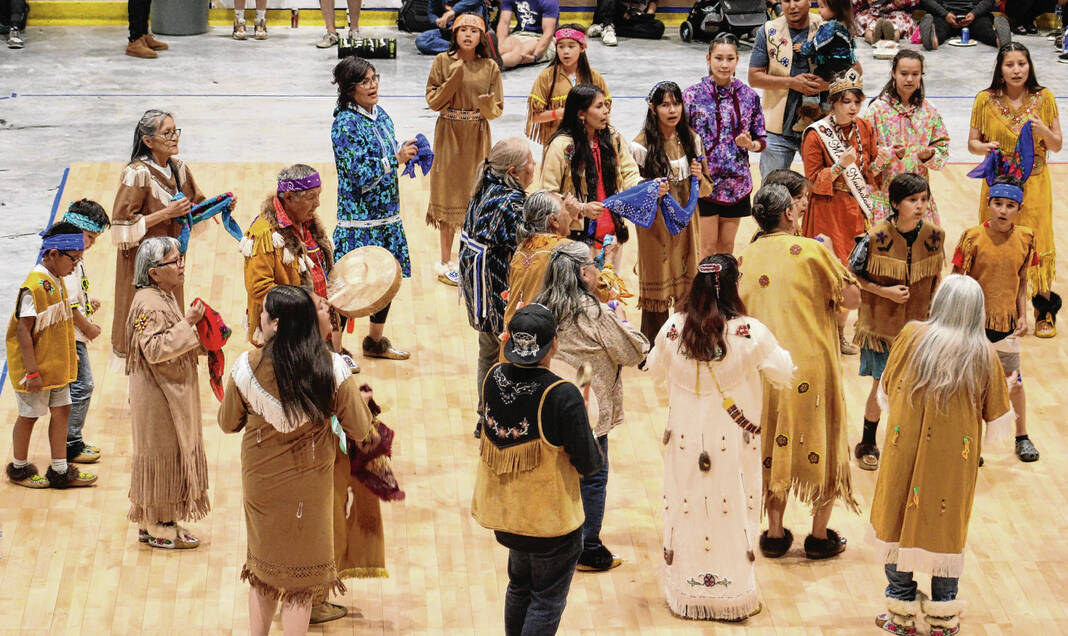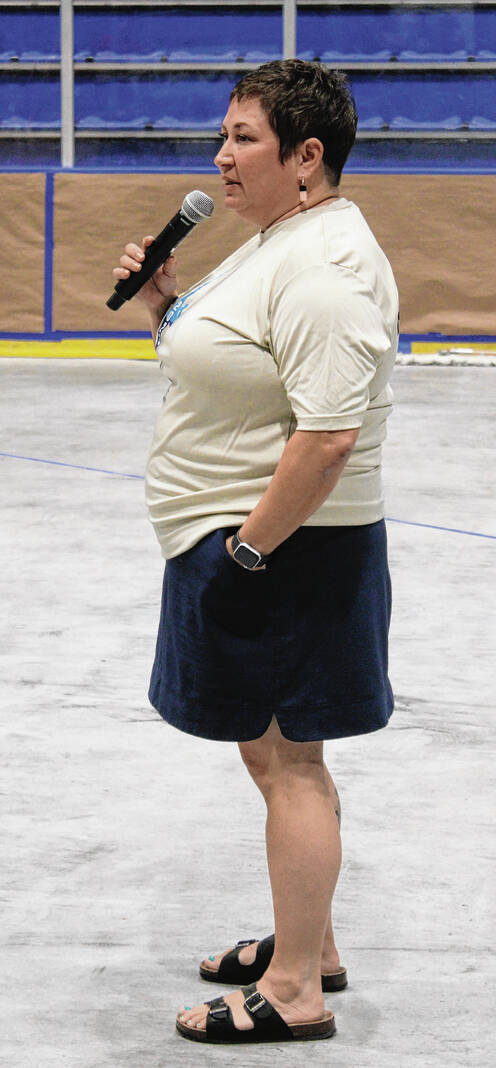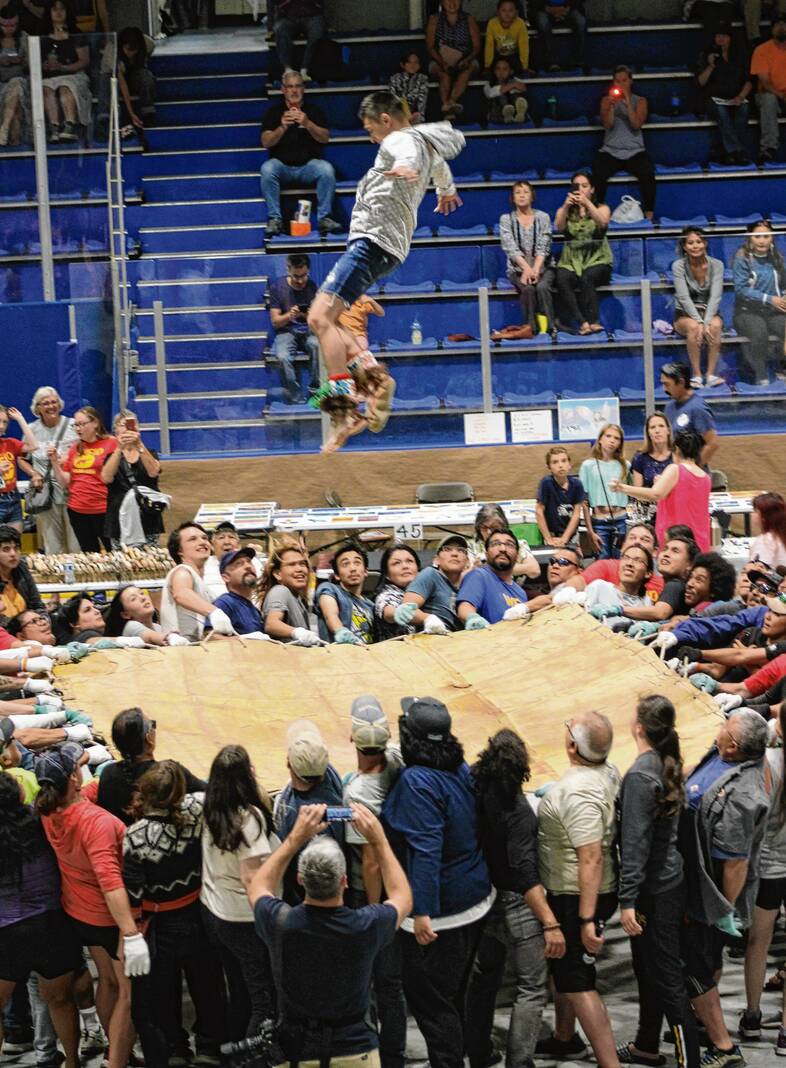
This silver medal is what prizes look like at the World Eskimo-Indian medals.

Allison Akootchook Warden acted as master of ceremonies, informing and entertaining the crowd during the July 12-15 event at the Big Dipper Ice Arena in Fairbanks.

Spiderkicker Matthew Chagluak, a high-schooler from Anchorage, demonstrated his devotion to Spider-man in the preliminaries of the Alaska high kick.

Brian Walker, a one-time champion in the stick pull, made a comeback at the 62nd annual games in Fairbanks last week.

This may look like a piece of cake, but it is actually muktuk, or whale blubber.

In some events, such as the Alaska high kick, or the 1-foot or 2-foot high kicks, competitors seek to tap a hanging seal fur ball with hand or feet.

One crowd-pleasing event is the blanket toss, where a competitor combines jumping and acrobatic ability with a team of “pullers” stretching tight a sealskin in an attempt to touch the ceiling of the Big Dipper Arena.

One crowd-pleasing event is the blanket toss, where a competitor combines jumping and acrobatic ability with a team of “pullers” stretching tight a sealskin in an attempt to touch the ceiling of the Big Dipper Arena.

Roy Ahmahgoak, wife Edna and daughter Janys of tiny Wainwright may be the farthest north Indiana women’s basketball fans in the United States.

One of the areas of competition at the games is dance, where representatives of a village, such as this group from Minto, Alaska, play music, sing and dance.

Nicole Johnston, a long-time star athlete, was the head official at the recent 62nd annual World Eskimo-Indian Olympics.

Competitors say they gain a feeling of flying in the blanket toss.
FAIRBANKS, Alaska — The strain of pulling was written on Ariella Derrickson’s face as she engaged in mini tug-of-wars with competitor after competitor until she had yanked the wooden stick free of everyone else’s hands.
Metaphorically, she was the last woman standing, although in reality she was the last woman sitting up straight, the gold medal winner in the Inuit stick pull.
The Athabascan woman from Tanana, in the state’s Interior, is 40 years old and has been coming to the annual World Eskimo-Indian Olympics for 35 of those years, but she never had entered this event which demonstrates strength needed to pull a seal up through the ice on a hunt.
“I think that our culture is just so precious,” Derrickson said of why she has been a regular at event for much of her life and now brings her children with her. “The belonging is so important.”
The 62nd annual event, conducted in mid-July, is a major sports gathering for people of the north, but is at least as much a symbol of and advertisement for Native culture. Spirit and pride permeated the atmosphere at the Big Dipper Arena.
Individual games contested for men and women are unlike those seen anywhere else in the United States. All are rooted in the subsistence lifestyle Eskimo and Indian peoples have followed for 10,000 years or more in a harsh and unforgiving environment.
Nicole Johnson, who grew up in Nome and now lives in Anchorage, began competing at 16 in 1985. Over the decades, she has won dozens of medals, served as president of the organization, is currently a member of the board of directors, and at these games was head official.
“I’ll be here as long as I possibly can,” Johnson said. “I didn’t realize how much of a community it was until I got here.”
The sportsmanship at the heart of the games is obvious. Unlike other sporting competitions, sometimes an athlete can be witnessed providing aid and advice, not just for the future, but on the spot to another out to beat him.
“People who come to watch these games are so intrigued by how everybody helps each other win,” Johnson said. “It’s like nothing they’ve ever witnessed.”
For those who attend, whether curious summer tourist, veteran watcher, WEIO is conscious of providing explanation through a master of ceremonies on a microphone.
When the medals were presented to the top three in the men’s Inuit stick pull, Allison Akootchook Warden, the master of ceremonies, teased, “Who’s ready to go out hunting with these men?”
Many games can be painful because they mimic tasks performed in minus-40 weather. The four-man carry involves an individual loaded down with four 150-pound men and walking as far as he can. That situation could be confronted in the wild bringing home a dead animal to feed the family.
David Edwards, 20, of Fairbanks, who placed second in the men’s Inuit stick pull, said he is hunting oriented.
“I can shoot,” Edwards said. “I love moose soup all the time. That’s one of my favorites.”
But Edwards, who weighs 235 pounds and is a former high school football player and shot put and discus thrower, entered the four-man carry for the first time and realized how hard it is.
“That was a full body experience,” he said.
The ear pull, where a string is looped over one ear as contestants sit facing one another while they yank their heads back, can be bloody. Withstanding that hurt imitates putting up with frostbite threat. The knuckle hop, mimicking the perambulation of a seal, may result in bloody knuckles.
Other events, such as the Alaska high kick, one-foot and two-foot high kicks and kneel jump, require dexterity and spring.
Still others are timed events, such as how fast one can eat a portion of muktuk, (whale blubber), or slice up a fish. Derrickson won gold in fish cutting, too.
There is a cute baby contest and also a pageant selecting a Miss WEIO, a revered title. It is not simply a beauty contest, but entrants are asked to think on their feet. One question being how they incorporate their culture into daily life.
Several of the young women spoke of working to keep Native languages alive.
Tiana Cozzen of Copper Center said, “I sing my heart out for my ancestors. I fish for my family.”
Jenysa Ahmaogak, whose father Roy is a whaling captain in their hometown of Wainwright, discussed whale hunting. Jenysa, Roy, and mother and wife Edna, who has coached the local girls basketball team to two state small-school championships, have become big-time fans of Indiana University women’s basketball. That is despite being located more than 3,300 air miles from Bloomington — and one cannot drive between the places.
Wainwright, a community of 600-plus on the Chukchi Sea, is located in Northwest Alaska, or, as Roy Ahmaogak said, “Go to Utqiagvik (formerly called Barrow) and turn left.”
One young man, Matthew Chagluak, an Anchorage high school student, asked for special permission to don a Spider-man mask when competing in the Alaska high kick. He was given the OK, as long as no other athlete complained. So, there was Spider-man in an untraditional event for him.
Why go all Marvel?
“I guess to be different,” Chagluak said. “One of these days I’ll break out a whole suit.”
As per custom, a special seating area was set aside called “the elders lounge” so senior citizens would not have to climb stairs into the arena stands.
Brian Walker, 59, of Eagle River, Alaska, who has attended WEIO for 36 years, once dominated the Inuit stick pull. He decided to enter against the young bucks once again.
“Is there an elders category?” he joked. Respect for age counted, experience not as much.
Walker, who stands more than 6 feet tall and has a hefty build, won his first match, which excited him because he was as nervous as a newcomer.
“All the muscle memory came back,” Walker said. “I’m still in at least two more times.”
He then lucked into a second-round bye. but lost twice in a row in the double elimination. Walker said the real pleasure for him was watching younger athletes take part.
“For me, it’s seeing the kids and the continuity from the elders,” Walker said.
That was no small thing. Gina Kalloch, a former athlete and now a member of the WEIO board of directors, said the group, like so many across America and the world, endured tough times during the COVID-19 pandemic.
It has taken a couple of years for athlete turnout to regain normal levels and Kalloch said she thought this year was a record with 160-plus athletes.
Upon reflection, the World Eskimo-Indian Olympics, founded in 1961 with the aim of showcasing Native abilities and acting as a conduit between generations stressing culture, has lived up to its goal, Kalloch said.
“It’s a way of teaching tradition, and you’re doing it,” Kalloch said. “Look how many young people are here competing. That’s why we exist.”
